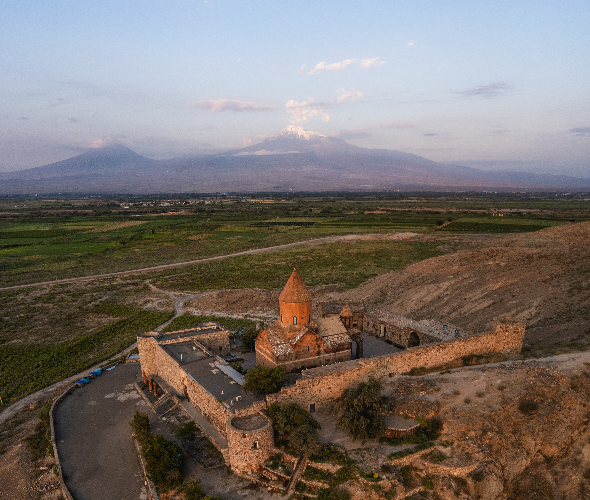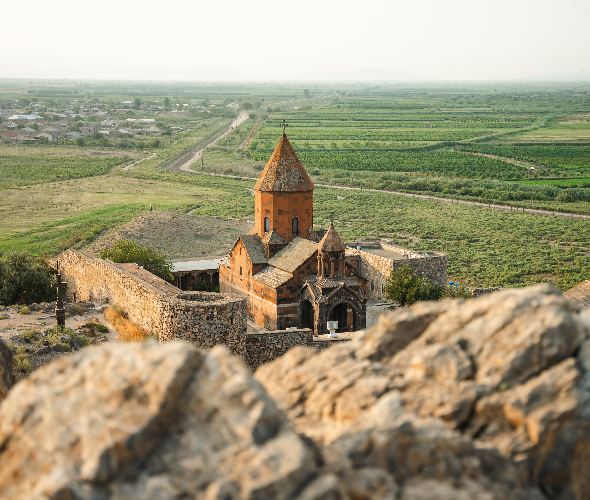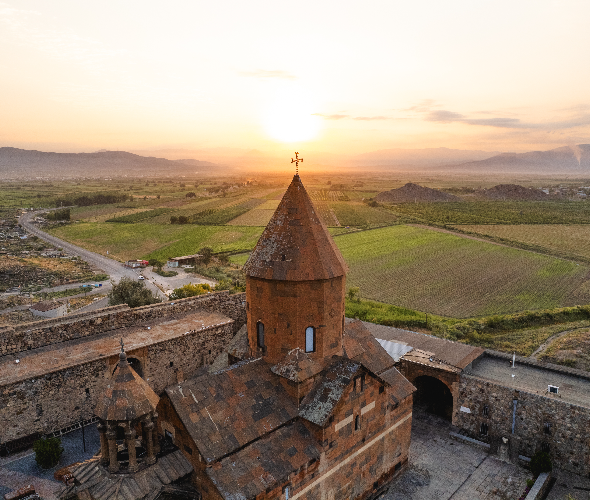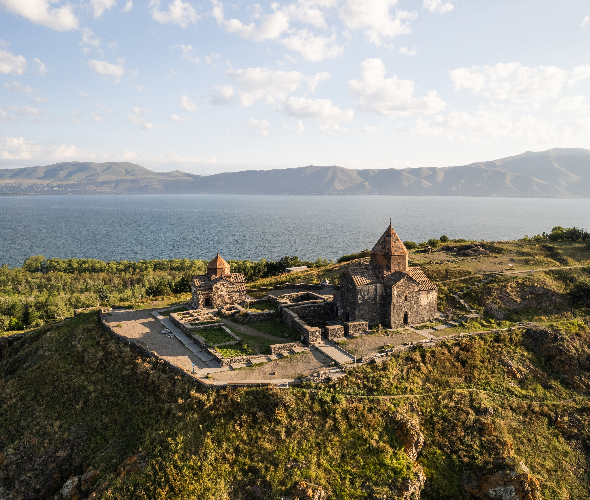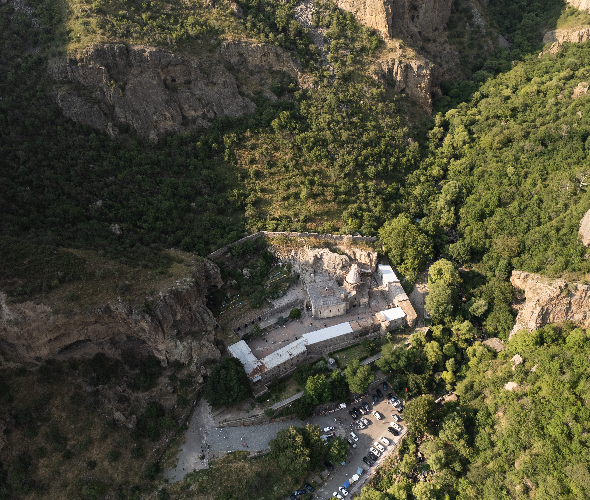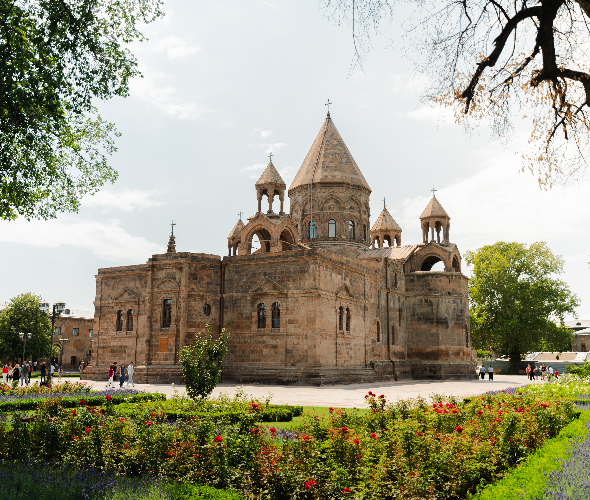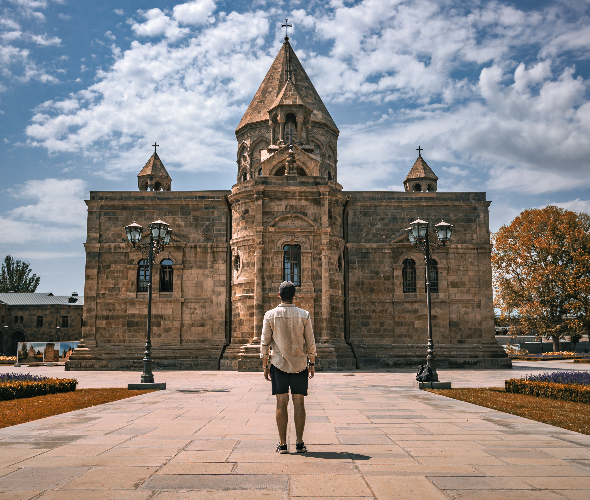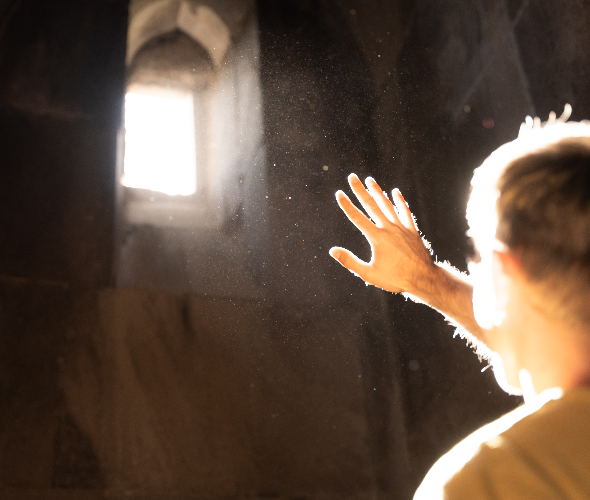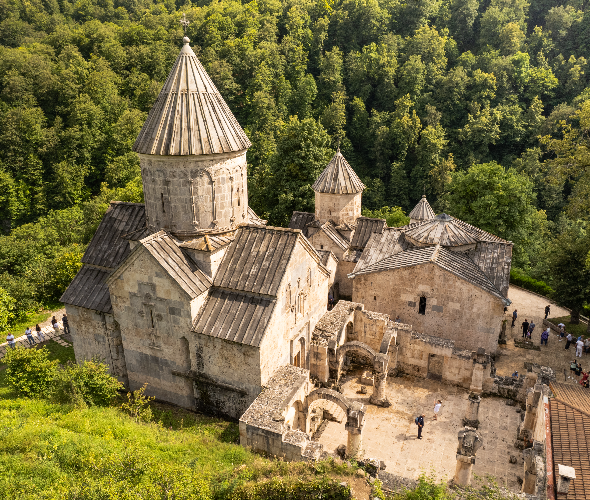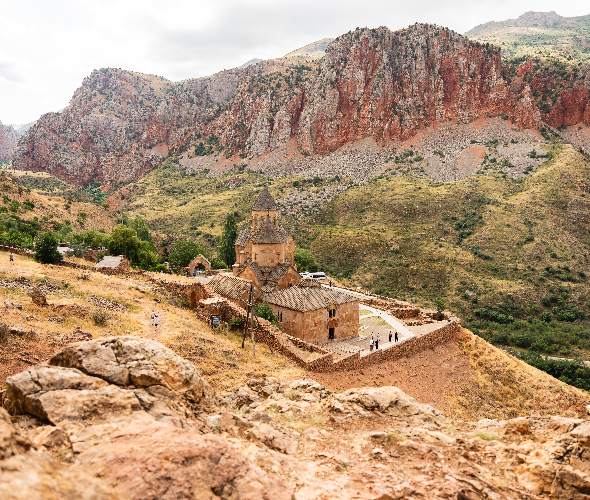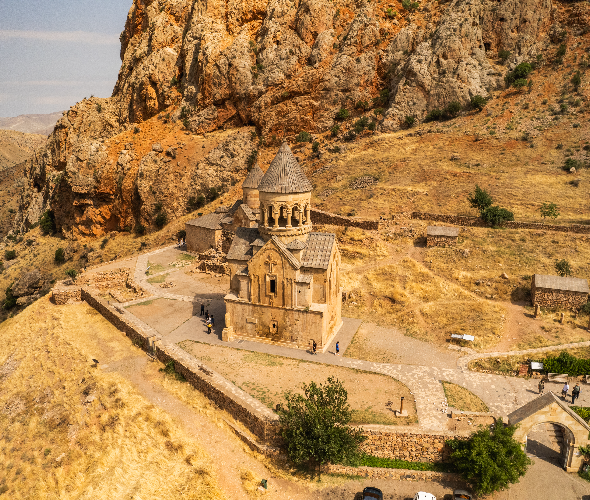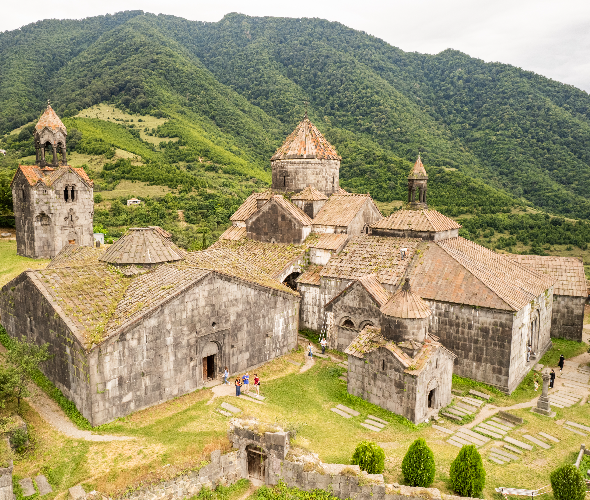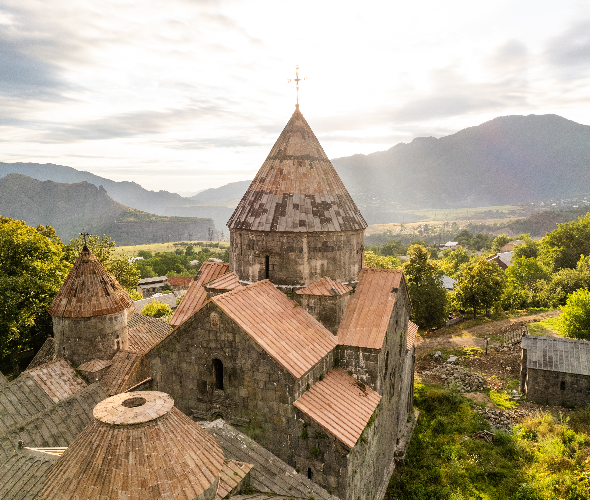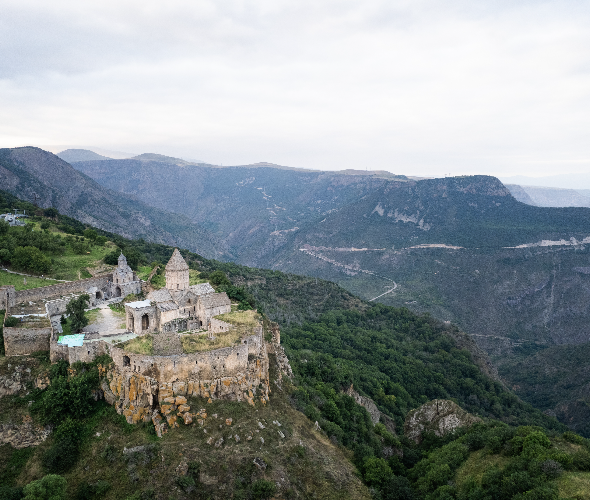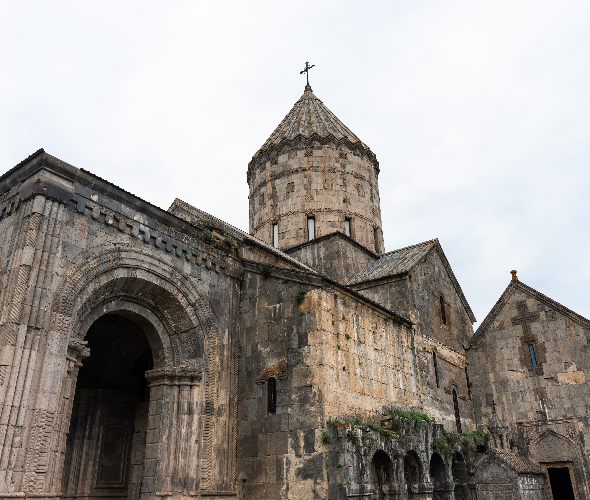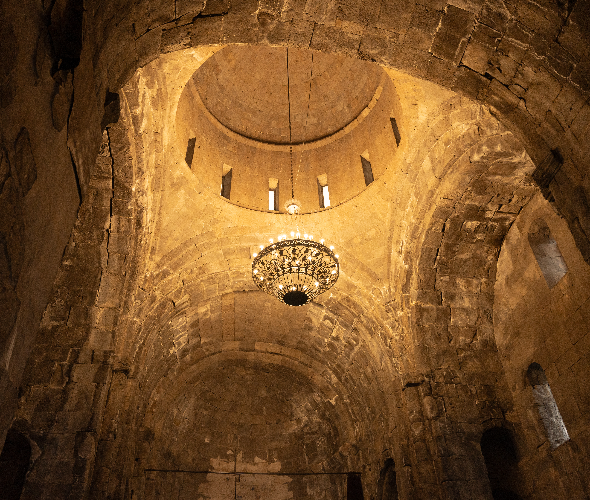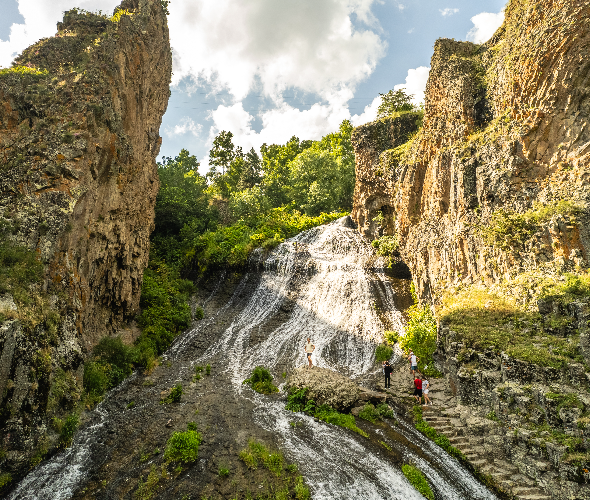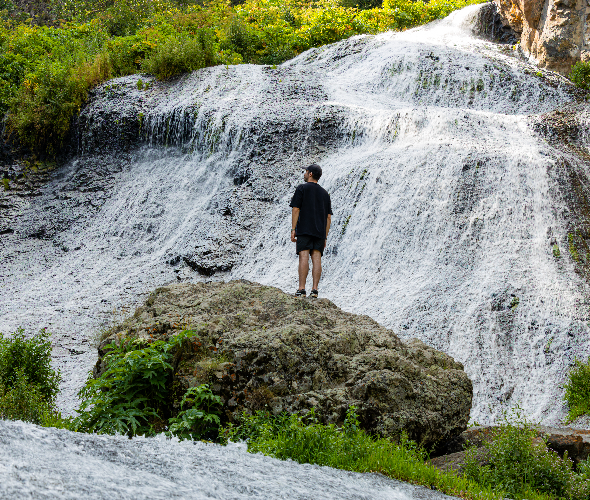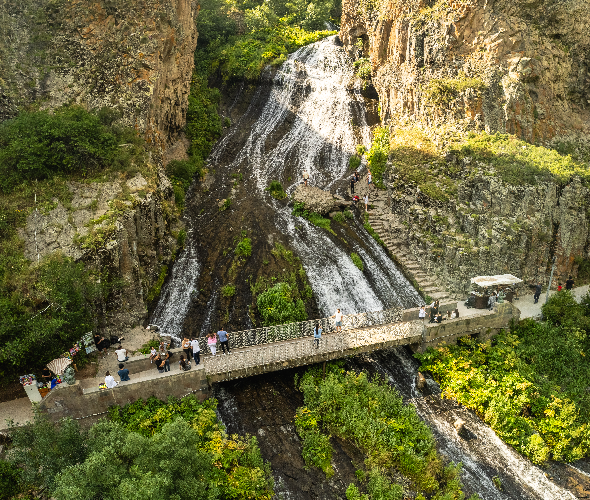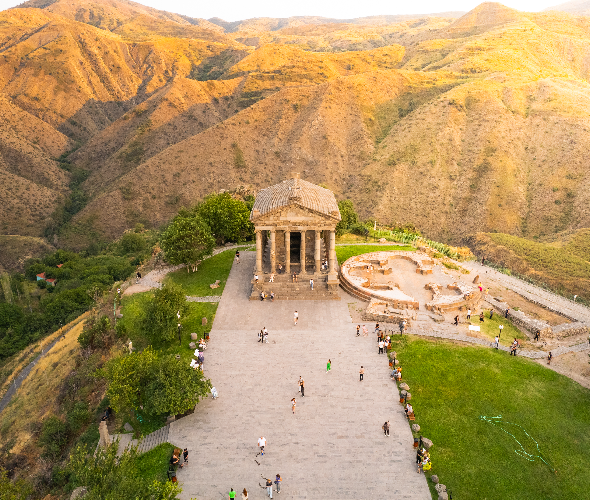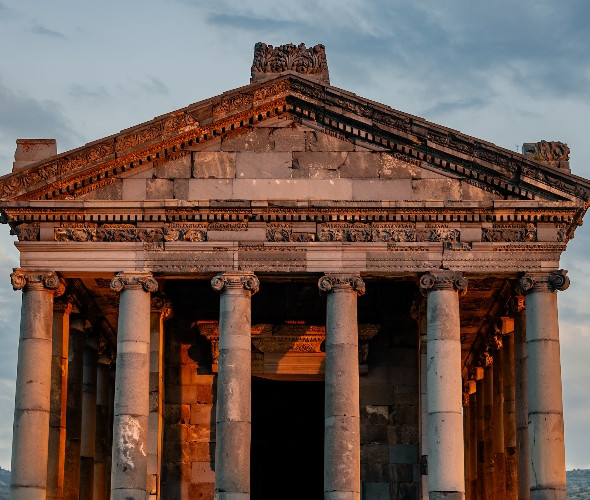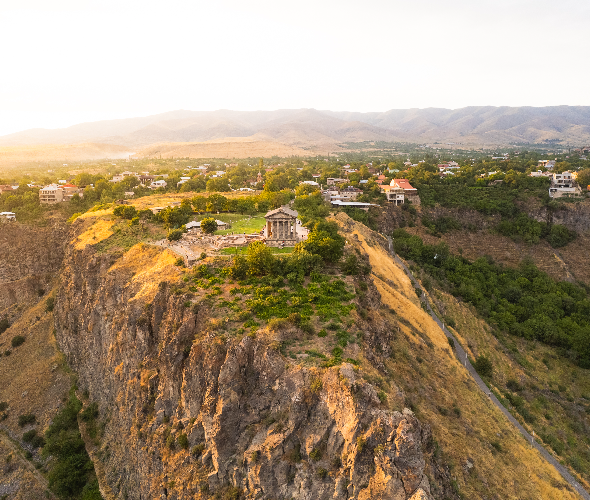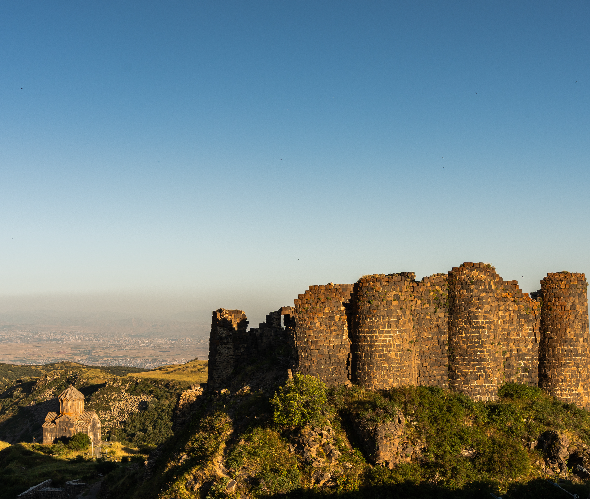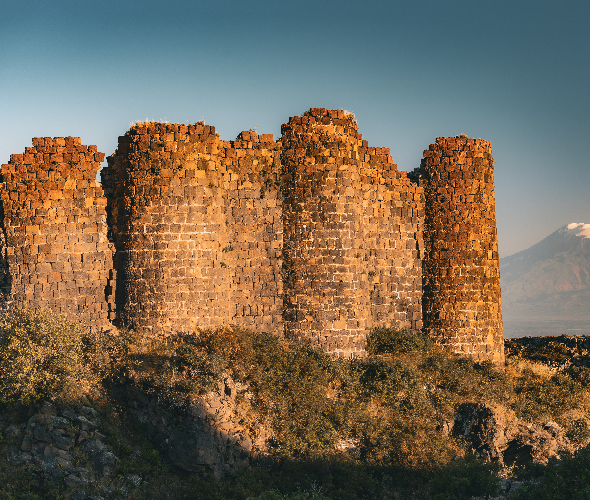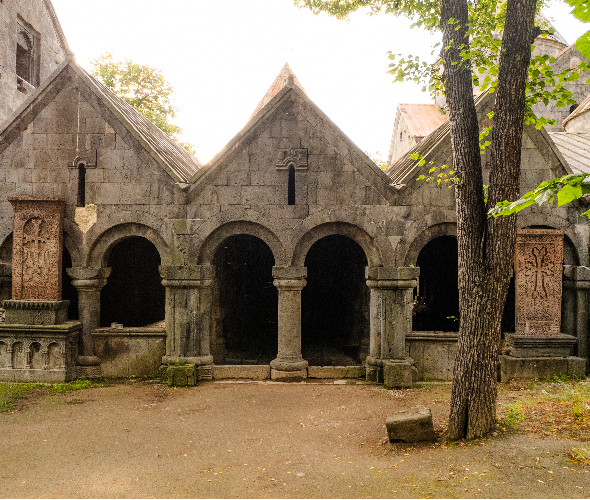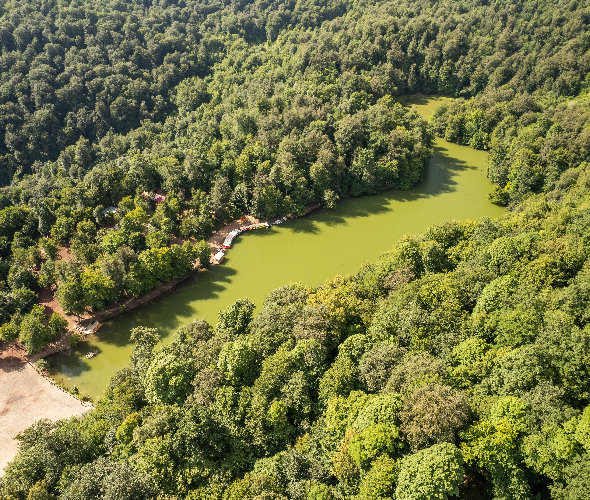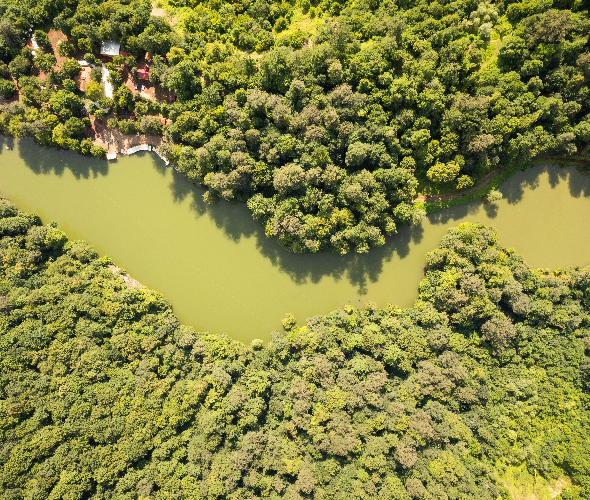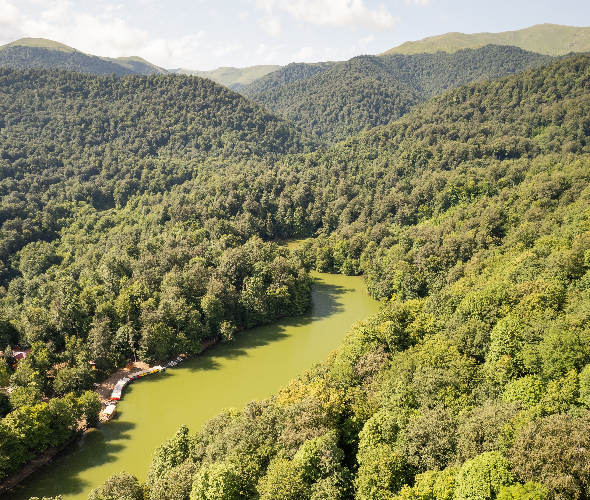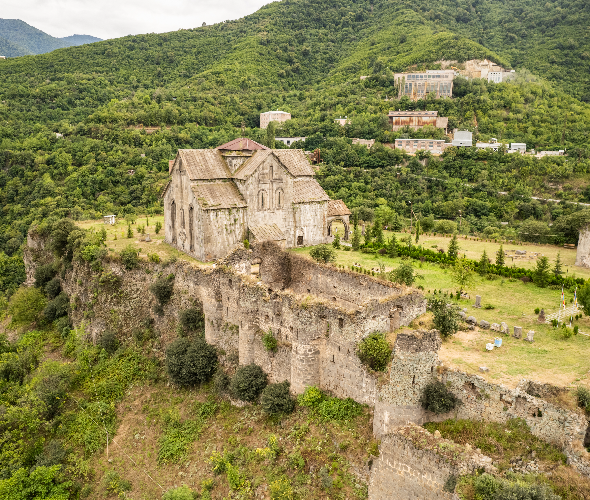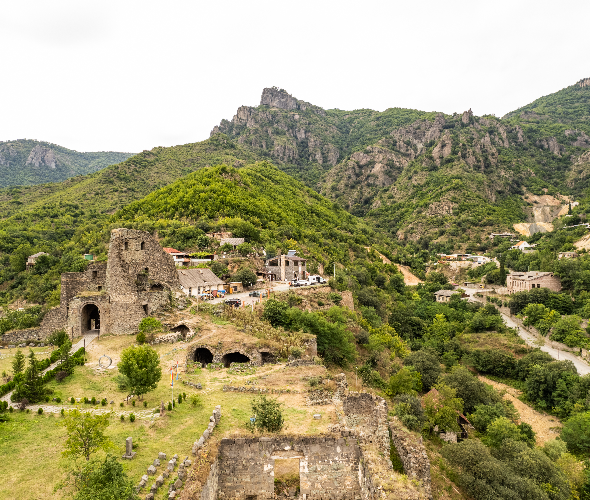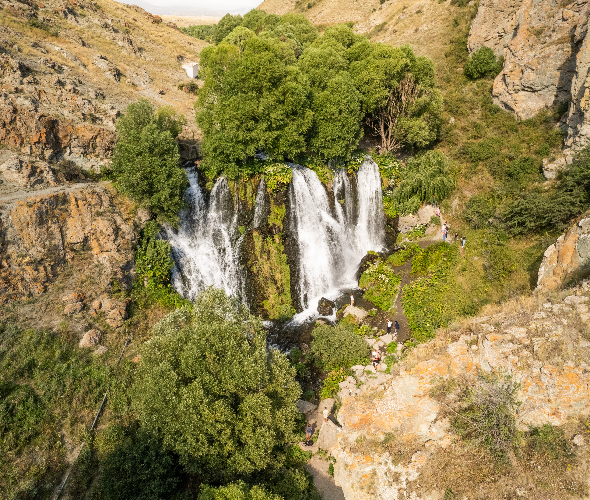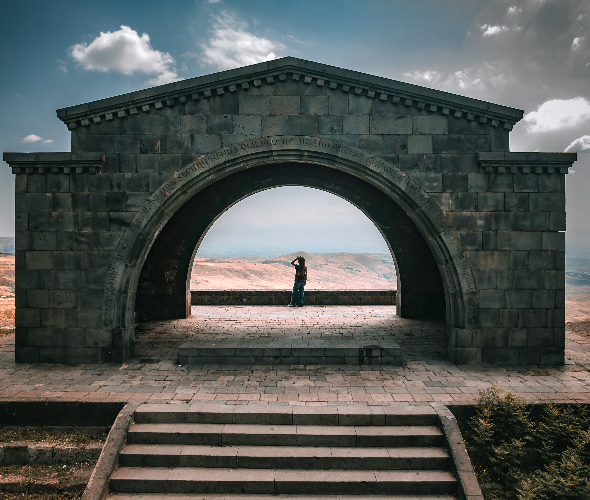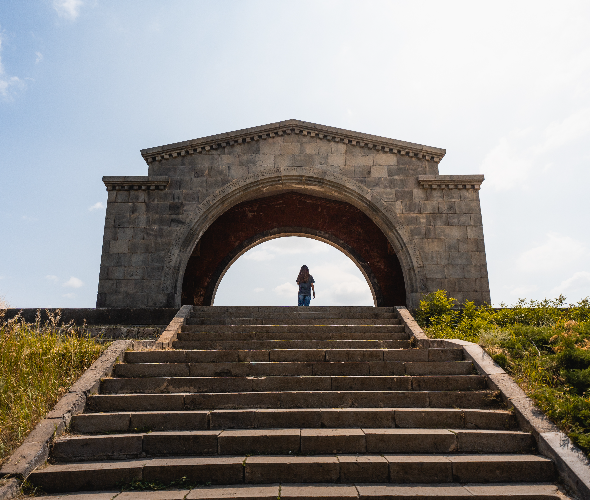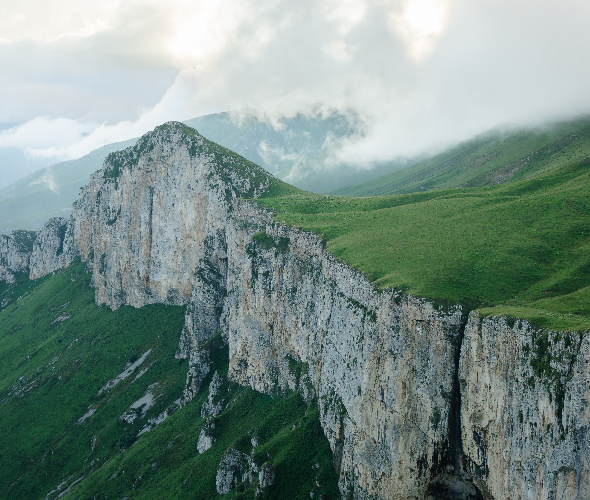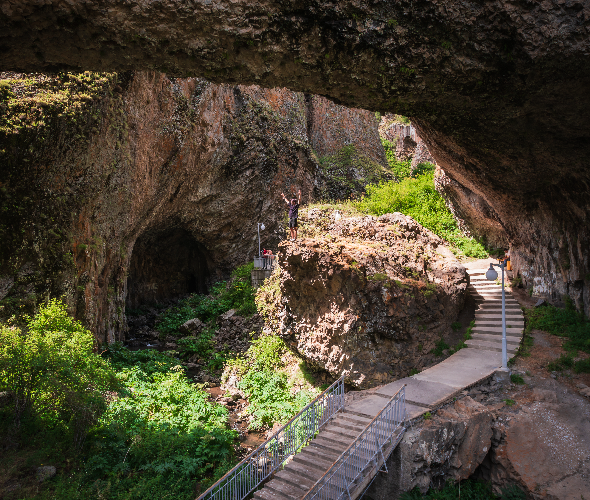
Gallery

Khor Virap Monastery
On the left bank of the Araks River lies Khor Virap, the history of which is closely connected with the period when Christianity was adopted as the state religion in Armenia. The ""Virap"" was a deep pit filled with snakes, scorpions, and poisonous insects, where the condemned were thrown. According to the historian Agathangelos, King Tiridates III the Great persecuted Christians, among whom was Gregory the Illuminator. By the king's order, Gregory was thrown into the royal dungeon pit in Artashat, where he spent about 14 years. During this time, Tiridates III the Great fell seriously ill, and according to his sister's dream, only Gregory the Illuminator could heal him. By the king's command, Gregory was released, he healed the king, and afterward, with the king’s support, Christianity was proclaimed the state religion. The Khor Virap monastic complex consists of the churches of Saint Gregory and Holy Mother of God. Khor Virap is an excellent example of a monastery-fortress, combining religious and defensive structures.
Khor Virap Monastery
Sevanavank Monastic Complex
One of the most well-known historical, cultural, and tourist sites in Armenia is the Sevanavank Monastic Complex, which was founded in 305 AD. According to tradition, Gregory the Illuminator established the monastery by placing a wooden cross on the site of a former pagan temple. Originally, Sevanavank consisted of four churches, a narthex, and auxiliary buildings, but today only two churches remain standing. Based on historical and inscriptional sources, these two churches were built in 874 AD. The all savior khachkar (cross-stone) of Sevanavank, depicting the crucifixion scene of Christ, is located in the church of the Apostles. According to the inscription, it was crafted in 1653 by Master Trdat, as an offering for the well-being of Hayrapet and Hrepeka. In addition to being a religious center, Sevanavank also served as one of medieval Armenia's notable fortresses. In 921, Armenian King Ashot II the Iron (ruling 914–921) fought an important battle against Arab forces here.
Sevanavank Monastic Complex
Geghard Monastery
Geghard Monastery is one of the most prominent medieval monastic complexes in Armenia, located about 35–40 km from Yerevan on the Yerevan-Garni-Goght road. According to tradition, it was founded in the early 4th century. In its early years, due to its cave structures, it was called Ayrivank (""Cave Monastery""). The name Geghard (""Spear"") became widespread in the 13th century in honor of the Holy Lance kept there—the spear that pierced Christ. The monastery’s oldest building is outside the main walls to the west: a semi-cave chapel from the 12th century. The main monument group formed in the 13th century includes the main church (Katoghike), an adjoining narthex, two cave churches, a narthex-tomb, and monks' cells. Geghard holds a special place in Armenian rock-cut architecture. A whole complex is carved into the massive northern cliff next to the main church: two small churches and a narthex at the top, and a columned narthex-tomb below. The surrounding area features exquisite khachkars and cave dwellings. The main church (Katoghike) was built by the Zakarian princes in 1215. The narthex, serving as a narthex for the main church, was built between 1215–1225. The first rock-cut church, northwest of the narthex, was built during the reign of Prince Avag, son of Ivane Zakarian, in the 1330s–1250. The second rock-cut church, northeast of the narthex, consists of a church and narthex, built in 1283 under Prince Prosh. The tomb of Papak, son of Prosh, and his wife Ruzukan, carved into the upper part of the rock, was built in 1288. It has a tunnel-like entrance about 10 meters long.
Geghard Monastery
Mother See of Holy Etchmiadzin
The Mother See of Holy Etchmiadzin is the spiritual and administrative center of the Armenian Apostolic Church. It is home to the Mother Cathedral, which, according to the vision of St. Gregory the Illuminator, was founded by the Descent of Jesus Christ and built by St. Gregory and King Tiridates III between 301–303 AD, following the adoption of Christianity as the state religion. For over 17 centuries, the Cathedral has been a sacred pilgrimage site for all Armenians and symbolizes the eternity of the Armenian people. Holy Etchmiadzin is the residence of the Catholicos of All Armenians. Though initially established here, the Catholicosate was, due to historical circumstances, temporarily relocated to other regions over the centuries. In 1441, the Catholicosate was permanently reestablished in Holy Etchmiadzin. For centuries, the Mother See has preserved unique Armenian manuscripts and masterpieces of ancient and modern art. The Mother Cathedral of Etchmiadzin is located in the city of Vagharshapat, Armavir Province. According to scholars, it is the first Mother Cathedral of ancient Armenia and one of the oldest cathedrals in the world. According to various interpretations, the architectural layout of the cathedral included forms such as a three-nave basilica, a rectangular structure with a four-pier central dome, a canopy resting on four columns in the shape of a Holy Cross, and a barrel-vaulted hall—essentially, it was constructed in nearly the same layout as it stands today. Its cruciform, central-domed, four-apse, four-pillar Armenian design has made a significant contribution to world Christian architecture. This type of layout began to spread in Europe in the 9th–11th centuries. The current dome dates back to the 17th century, and its drum features relief portraits of the apostles carved into medallions on its twelve panels.
Mother See of Holy Etchmiadzin
Haghartsin Monastery
The Haghartsin Monastic Complex, built between the 10th and 13th centuries, is located 18 km from Dilijan, nestled in forest-covered mountains. There are no written records about the monastery’s foundation, and it is unknown who built it and when. However, based on historical events, scholars believe that Haghartsin was founded during the Bagratuni dynasty. The complex consists of three churches, two narthexes (one in ruins), a refectory and several chapels. Saint Gregory Church is the oldest structure in the complex, built in a cross-domed architectural style. Saint Stepanos Church is attached to Saint Gregory on the north and features a dome. The Narthex is located west of Saint Gregory, built in the late 12th century under the patronage of Ivane Zakaryan. Saint Astvatsatsin Church is the main church of the complex, designed as a domed hall. In front of this church, the remains of a ruined narthex are still visible. Beneath the southern wall of Saint Gregory’s narthex, there is a royal tomb. Only one tombstone inscription has been deciphered, revealing that King Smbat I of the Bagratuni dynasty is buried here. The other tombstones likely belong to Kyurikian kings. Designed by architect Minas, the refectory holds a unique place in secular Armenian architecture. It is a rectangular hall, divided into two equal sections by paired columns.
Haghartsin Monastery
Noravank Monastery
"One of the most magnificent medieval monastic complexes of Armenia, Noravank, is often called Noravank of Amaghu, as it is located near the village of Amaghu. It has a unique and extremely impressive architectural style that is hard to confuse with any other complex. Noravank is situated in a gorge of red volcanic rocks, which further emphasizes its unique beauty. Noravank was founded in the 9th century but was mainly rebuilt in the 13th-14th centuries. The Noravank monastic complex consists of the Holy Mother of God Church (Burtelashen), the Saint Stephen Nakhavka Church, the narthex adjacent to it from the west, the Church of Saint Gregory (the tomb of Stepanos Orbelian), remains of medieval chapels and buildings, and a newly built monastery. Due to its rich sculptures, exceptional khachkars (cross-stones), and numerous valuable inscriptions, Noravank is considered a unique cultural heritage."
Noravank Monastery
Haghpat Monastic Complex
The Haghpat Monastic Complex was founded in 976, during the reign of King Ashot III of the Bagratuni dynasty, and was built on the elevated southeastern part of the village. The complex consists of cathedrals, narthex halls, chapels, a scriptorium, a bell tower, a refectory, and mausoleums. The main church, Surb Nshan (Holy Sign), was built between 970 and 991 by Queen Khosrovanush. It is a domed cruciform church, rectangular on the outside and cross-shaped on the inside. Among the preserved frescoes are a depiction of Christ and some Gospel scenes. The main narthex is attached to the western side of Surb Nshan and was built in the 13th century by Princess Mariam. It stands out for its volume and stone inscriptions. To the south and north of the main church are the St. Gregory and Holy Mother of God churches, both cruciform and domed in design. North of the cathedral is Hamazasp’s chapel, which includes a small chapel and, to the south, a rebuilt scriptorium. The scriptorium was considered an important center of manuscript writing, where ancient manuscripts were preserved and recopied. The most notable structure in the complex is the three-story bell tower, a tower-like structure with a cruciform layout and crowned with a dome. It is remarkable for its architectural harmony and elegance. To the north lies the refectory, a vaulted hall with two columns. The complex also contains arched halls that served as mausoleums, with floors covered in tombstones and housing the famous Amenaprkich Khachkar (Holy Savior Cross-stone).
Haghpat Monastic Complex
Tatev Monastery
Tatev Monastery is located in the village of Tatev, in Syunik Province. In the Middle Ages, it became a major center of spiritual, cultural, and political life. The princes of Syunik, closely connected to the Arsacid royal family, greatly supported monastic life by donating estates, lands, and villages, and by building churches. The first structures of the monastic complex were built in the 4th century, shortly after the Christianization of Armenia. Starting from the 9th century, Tatev developed into a full-fledged monastic complex. It was officially founded in 844 by Bishop David in the village of Tatev. The Church of St. Gregory the Illuminator was built in 848, followed by the Church of Saints Peter and Paul (895–906), which is noted for its size, architectural design, and rich interior decoration. Relics of Saints Peter and Paul were placed in the foundations of the church during its construction. In front of the church’s southern entrance stands a unique architectural monument known as the Gavazan (pillar), which had the ability to sway due to its movable base. The monastery was fortified with walls and included a narthex, treasury, scriptorium, hiding places, refectory, workshops, monastic cells, and burial vaults. In the 9th to 11th centuries, the monastery housed about 500 monks, and operated a spiritual seminary, which later became a university. In 1170, the Seljuk-Turkish invasions led to the fall of the Kingdom of Syunik, and Tatev Monastery was devastated. Its library was burned, and about 10,000 manuscripts were lost. The clergy relocated to Noravank in Vayots Dzor. Later, in the 13th century, under the Orbelian princes, the monastery was rebuilt. From the 1280s, Tatev Monastery became a center of resistance to foreign religious influences, preserving the Armenian Church’s identity against external religious currents. The University of Tatev, officially established in the 14th century, became a pan-Armenian intellectual and educational center. Prominent theologians, philosophers, astronomers, miniature artists, and musicians worked there. Its library remained active until the early 20th century. A two-story arched belfry (14th century) and a school of miniature painting were also built in the monastery courtyard. During Timur’s (Tamerlane’s) invasions in the late 14th century, the monastery was again destroyed, and Bishop Shmavon was forced to move to Sanahin. However, in the 17th–18th centuries, the monastery saw a revival due to the active involvement of the church and noble elite. From the late 19th century, Tatev also became a significant site in the Armenian national liberation movement. During the Zangezur self-defense struggle (1919–1921), Tatev Monastery served as one of the main strongholds of Garegin Nzhdeh. Two pan-Zangezur congresses were held here, proclaiming the independence of Mountainous Armenia, followed by the Republic of Armenia, in opposition to Soviet rule. The 1931 earthquake caused major damage to the monastery. During the Soviet era, it was mostly abandoned and neglected by the state. Only in the 1970s did restoration begin, during which the churches, main dome, and the lower level of the belfry were reconstructed.
Tatev Monastery
Jermuk waterfall
"Jermuk Waterfall, also known as “Mermaid’s Hair,” is one of Armenia’s most beautiful waterfalls, located in Jermuk city, Vayots Dzor province. A fascinating legend is associated with the waterfall’s name. According to the tale, a noble Armenian family once lived on the cliffs, and their beautiful daughter fell in love with a shepherd’s son. Every night, she would lower a long rope to help him climb up for a secret meeting. When her father discovered their love, he cursed her, saying: “If you meet him again, you will turn into a mermaid and never leave the water.” On their next meeting, the curse came true—the girl transformed into a mermaid, and her flowing hair became the cascading waterfall. This is why Jermuk Waterfall is sometimes called ‘Mermaid’s Hair’."
Jermuk waterfall
Garni Temple
The Pagan Temple of Garni is located in Garni village, Kotayk Province. It represents a unique fusion of Hellenistic and Armenian architecture and culture. Scholars believe the temple was dedicated to the pagan sun god Mihr (Areg), the patron god of King Trdat I. After his enthronement in Rome, Trdat built this temple in Garni in honor of Mihr. The term ""mehean"" (used for pagan shrines) derives from Mihr’s name. After returning to Armenia in 66 AD, Trdat initiated large-scale construction, including restoration of the Garni Fortress, the temple, and the royal baths. In the 7th century, St. Sion Church was also built nearby. With the adoption of Christianity in the 4th century, the temple was converted for Christian use. Its cella (inner chamber) was demolished and replaced with a church, and its pagan elements—altars and idols—were removed. The temple, built in Hellenistic style, belongs to the peripteral type (surrounded by columns), a hallmark of Ancient Greek religious structures. The nine steps leading up to it are also typical of pagan temples. The 1679 earthquake destroyed the temple completely. It was rebuilt between 1969–1975, restoring its original form.
Garni Temple
Amberd Fortress
Amberd is one of the most remarkable medieval fortress-cities of Armenia. It is located on the southern slope of Mount Aragats, about 7 km northwest of the village of Byurakan, on a triangular promontory formed by the confluence of the Arkashen and Amberd rivers. The fortress was built according to the principles of ancient and medieval Armenian fortress construction, surrounded on all sides by deep gorges, forming a natural and powerful defensive system. The exact founding date of Amberd is unknown. It has been attributed to the Cyclopean, Urartian, or early medieval periods, but archaeological research indicates that the fortress was constructed between the 9th and 13th centuries. Construction began in the 7th century by the Kamsarakan family. In the 10th century, it came under the control of the Pahlavuni princes, becoming a key defensive stronghold of Bagratid Armenia. Later, it passed to the Zakarians, and then to the Vachutians, who turned the fortress into an administrative center. The Amberd fortress-city includes a castle, bathhouse, chapel, the Cathedral of Vahramashen, an oil mill, and a strong defensive system with high and thick walls. The chapel is located about 9 meters from the bathhouse and dates to the 10th century. The Katoghike Vahramashen Church was built in 1026, sponsored by Vahram Pahlavuni, and is located at the highest central point of the fortress. Excavations at Amberd have uncovered metal objects, weapons, silver jewelry, bronze candlesticks, pottery, glassware, copper and gold coins, and candleholders.
Amberd Fortress
Sanahin Monastic Complex
The Sanahin Monastic Complex was founded in 966 with the support of King Ashot III the Merciful. This ancient site became not only the dynastic mausoleum and administrative center of the Kyurikians, but also the spiritual seat of the kingdom. The name Sanahin is believed to derive from the phrase “this is older than that”, referring to the fact that it was built after the Haghpat Monastery. The complex consists of sacred and civil structures built in different periods. It includes churches, narthex halls, scriptoria (libraries), and mausoleums. The oldest structure, the Holy Mother of God Church, established Sanahin’s position as a spiritual center. Next to it developed seminaries and scriptoria, which later evolved into a university and an academy. The dominant structure of the complex is the Church of the Holy Redeemer with its cross-shaped layout and massive dome. Adjacent to it is St. Gregory Church—circular from the outside and cruciform with four apses on the inside. It is built on a strong stone foundation, and its library is attached to its northern side. The Sanahin library, the largest and oldest among medieval Armenian scriptoria, served not only as a repository for books and manuscripts but also as a treasury for sacred relics and remains. The academy is situated between the Holy Mother of God and Holy Redeemer churches and is attributed to Grigor Magistros Pahlavuni. Symbolically, its floor is covered with tombstones, and three khachkars (cross-stones) stand in the eastern part of the hall. Outside the main complex are preserved the mausoleums of the Argutyan-Yerkaynabazuk and Zakarian families, as well as the churches of St. Jacob, St. Resurrection, St. Karapet, and the Chapel of St. Sarkis. The Zakarian mausoleum is located in the southeastern cemetery, and St. Resurrection Church is unique for its double apses on the eastern side.
Sanahin Monastic Complex
Lake Parz
Located in Dilijan National Park, Tavush region, at an altitude of 1,330 meters, Parz Lake is a hidden gem nestled in dense forests and is fed by natural springs. The lake is 300 meters long, 100 meters wide, with an average depth of about 3 meters and a maximum depth of 10 meters. The road to Parz Lake winds through Dilijan National Park's lush green forests. Along the way, visitors can see Armenia’s only breeding center for Caucasian deer, where the deer are raised, cared for, and released into the wild. Parz Lake is well-known for its scenic hiking trails, with the most popular route leading to Gosh Lake. This 10 km trail passes entirely through the forests of Dilijan National Park.
Lake Parz
Akhtala Monastery
On a high promontory rises the Akhtala Monastery of the Holy Mother of God—one of the significant spiritual and cultural centers of its time. This area, originally called Agarak and later Pghndzahanq (Copper Mine), was known in the Middle Ages as a religious and educational center for the Chalcedonian Armenians under Georgian rule. However, the historical foundation of the monastery is rooted in the Armenian Apostolic faith, which laid the groundwork for the birth and further development of the monastic complex. The monastery is surrounded by pyramid-shaped walls built as early as the 10th century during the Kyurikian Bagratuni period. The northern entrance is a vaulted hall, attached on the east to a three-story pyramid-shaped tower. The main church of the complex, the Church of the Holy Mother of God, is located in the very center of the fortress. It has a domed structure, with double-story sacristies on either side of the altar. The dome has been destroyed over time, but its foundations, columns, and wall supports remain. The exterior façades are adorned with niches, cross-reliefs, and rich decorative stone carvings. In the monastery courtyard, a 13th-century single-nave church with a semicircular altar has been preserved, along with remnants of residential and economic buildings. Inside the monastery, the walls are entirely covered with exquisite frescoes. This artistic legacy is unique in both scope and content, depicting scenes from the Old and New Testaments—images of the Virgin Mary, John the Baptist, and numerous biblical events. Though dating to the 13th century, they have preserved their appearance and colors to this day. Only two base colors were used in the murals: vordan karmir (cochineal red) and lazurite (blue made from copper), with the rest of the tones created by blending these. The monastery was also a major center of manuscript writing. In the 13th century, Simeon Pghndzahantsi worked here, and both Armenian and Georgian literature was studied. According to Stepanos Orbelian, the ""God-received Holy Cross,"" donated by Ivane Zakarian to Noravank, was once kept here.
Akhtala Monastery
Shaki Waterfall
The Shaki Waterfall is located 3 km northwest of the town of Sisian, on the Shaki River, which is a tributary of the Vorotan River. The waterfall has a height of 18 meters.
Shaki Waterfall
The Arch of Charents
The Arch of Charents monument is located in the village of Voghjaberd in the Kotayk Province, on the right side of the Yerevan-Garni road, at an elevation of about 1500 meters above sea level. The arch is also known by other names such as the Arch of Ararat or the Temple of Ararat. It is constructed externally from basalt, with its inner facing made of orange tuff stone. The monument was designed by architect Rafael Israelyan and built in 1957. While traveling to Garni, Israelyan stopped at this spot and, captivated by the stunning view of Mount Ararat, decided to build an arch—a symbolic ""temple"" to Ararat. Along the arch is engraved a famous couplet from the great Armenian poet Yeghishe Charents's poem ""To My Sweet Armenia"": “Pass through the world, no peak like Ararat will you find, Like the path to unreachable glory, I love my Mount Masis.” This is why the monument is more widely known as the Charents Arch. From a distance, the structure appears to have naturally risen with the hill, serving as a platform from which to gaze upon Mount Ararat and appreciate its majesty. Israelyan succeeded in capturing the grandeur of a colossal mountain within a modest architectural form.
The Arch of Charents
Mount Dimats
Dimats Mountain is located in the Ijevan Mountains of the Tavush region. It is 5 km north of Teghut village in a straight line. The height of the peak is 2378 meters. Recently, hikes to Dimats Mountain have become more frequent, as it has become a popular tourist destination, greatly loved by hikers and nature enthusiasts. The unique feature of Dimats Mountain is that from its peak, there is a stunning view of the rocky wall of the Ijevan Mountains.
Mount Dimats
Arch of Dreams
"The Arch of Dreams is located in the town of Jermuk, near the Mermaid's Hair Waterfall. It is a beautiful natural creation and a geological monument that locals also call the ""Arch of Fate"" or the ""Arch of Happiness."" This arch is famous for its miraculous power—legend has it that anyone who passes under it and makes a wish will see their wish come true. The arch is 30 meters long and 15 meters high."
Arch of Dreams
